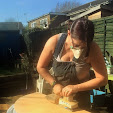Please don't get so lost in the sensational story of her injuries and the fact that she now looks so unscathed that you lose the message that this young woman was moved into an old age home, and that fact probably saved - if not her life - her ability to function and lead the life she has.
This was radical collaboration. A bunch of people came together and taught her some vital skills. Sometimes they were skills the bunch of people didn't have themselves, so they more or less made it up as they went along. Others were skills some members of the bunch had honed and flexed decades previously. This was outside the box/left field/pick your cliche thinking in action. Was this bunch a collection of young buck mavericks, known for flying off at a tangent? Not even a little bit. This was a bunch of senior citizens in an old age home. They didn't hold a thought shower. They didn't run a few ideas up the flagpole and see who saluted. They all just pitched in and did what they could. It was probably quite messy, because it was life and not corporate business. And just look at their results.
By and large, people in old age homes are considered to have done their bit for society. They are now being afforded the chance to put their feet up and take it easy in the final years of their lives. They can even be quite disempowered. They are as likely to be 'done to' as school children - not consulted about their schedules and preferences, but with activities planned and scheduled by well-meaning people who believe they know what's best for them. Old age homes aren't exactly sought after harvesting grounds for recruitment agencies. And yet, and yet.
I find this story inspiring on so many levels.
I am also inspired by Pierson's approach to recruitment (among other things). However, rather than diluting this particular slant by going down that rabbit hole, let me leave you with a link to an interview she did with Business Week, so that you can explore more on your own.


